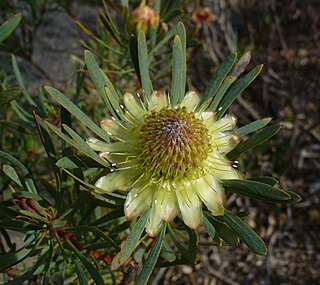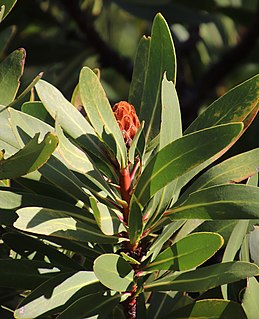
Erythrina is a genus of flowering plants in the pea family, Fabaceae. It contains about 130 species, which are distributed in tropical and subtropical regions worldwide. They are trees, with the larger species growing up to 30 m (98 ft) in height. The generic name is derived from the Greek word ερυθρóς (erythros), meaning "red", referring to the flower color of certain species.

Euclea, from the Greek eukleia meaning "glory and fame", denotes a group of flowering plants in the Ebenaceae or ebony family. They were described as a genus by Linnaeus in 1774. The genus includes evergreen trees and shrubs, native to Africa, the Comoro Islands and Arabia. Several species are used for timber, producing a hard, dark heartwood timber similar to ebony.

Protea laurifolia, also known as the grey-leaf sugarbush, is a shrub from South Africa. It is native to the Cape Provinces of South Africa.
Erythrina schliebenii is a species of legume in the family Fabaceae. It is found only in Tanzania. The species is named for German collector and botanist Hans-Joachim Schlieben.

Leucadendron strobilinum, commonly called the peninsula conebush, is a plant species in the genus Leucadendron—forming part of the family Proteaceae. Confined to the Cape Peninsula, it reaches a height of up to 2.6 metres growing in southern, damp rocky slopes at an elevation of 500 to 1100m. Its conservation status is Near Threatened—a result of inappropriate fire management, fire-break clearing and alien plant invasions.

Protea scolymocephala, also known as the thistle protea or thistle sugarbush, is a flowering plant from the genus Protea native to South Africa.

Protea acaulos, also known as the common ground sugarbush, is a flowering plant found in the southwestern Cape Region, South Africa. It is also simply known as ground protea; in the Afrikaans language it is known as an aardroos.

Petalidium, commonly known as petal-bushes, is a genus of perennial shrubs in the acanthus family. They are native to sandy flats or stony slopes in the drier bush regions of Africa, India and the Mascarene Islands. The majority of species occur in frost-free, summer rainfall regions of southern Africa, and may be found from low to medium altitudes.

Scutia myrtina is a species of plant in the family Rhamnaceae. It is commonly known as cat-thorn.
Hypertelis is a genus of flowering plants in the family Molluginaceae. Most of its former species have been transferred to the new genus Kewa, and the remaining species, Hypertelis spergulacea, may also need a different placement. Hypertelis spergulacea is a woody-based plant, up to 30 cm (1 ft) high, with whorled greyish green leaves. It is found on the border between Namibia and the Northern Cape province of South Africa.

Polygala rehmannii is a species of flowering plant in the milkwort family (Polygalaceae). It is endemic to areas with an altitude below 1,160 metres (3,810 ft) in Southern Africa. It was first described by Robert Chodat in 1893.

Protea effusa, sometimes known as the scarlet sugarbush, is a flowering plant which belongs to the genus Protea. The plant is endemic to the Western Cape province of South Africa. In the Afrikaans language the vernacular name blosrooisuikerbos has been recorded for this plant.

Protea namaquana, also known as the Kamiesberg sugarbush, is a flowering plant which belongs to the genus Protea. The plant is endemic to the southwestern Cape Region of South Africa, in particular the Kamiesberg mountains of Namaqualand in the Northern Cape province. The species has a worldwide distribution of only 18 km2. It is regarded as critically endangered. In the Afrikaans language it has the vernacular name is Kamiesbergsuikerbos.

Protea rubropilosa, also known as the Transvaal sugarbush, escarpment sugarbush or Transvaal mountain sugarbush, is a flowering tree, that belongs to the genus Protea in the family Proteaceae. The plant only occurs in South Africa.
Protea pudens, also known as the bashful sugarbush, is a low-growing, groundcover-like, flowering shrub in the genus Protea. It is only found growing in the wild in a small area in the Western Cape province of South Africa.

Protea stokoei is a flowering shrub which belongs to the genus Protea. The plant is endemic to South Africa. It is found in the Kogelberg and Greenland mountains around Elgin.

Protea burchellii, also known as Burchell's sugarbush, is a flowering shrub in the genus Protea, which is endemic to the southwestern Cape Region of South Africa.
Protea convexa, also known as large-leaf sugarbush, is a rare flowering shrub in the genus Protea of the family Proteaceae, which is endemic to the southwestern Cape Region of South Africa.

Cotula turbinata is a herb in the Asteraceae family native to the Cape Province, but found in India and in Australia

Protea aurea subsp. potbergensis, also known as the Potberg protea, or Potberg sugarbush, is a flowering plant of the genus Protea. It is endemic to South Africa and is found only in the Potberg near Cape Infanta. It grows to a height of 5 metres, and flowers primarily from May to June.
















